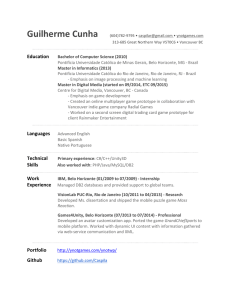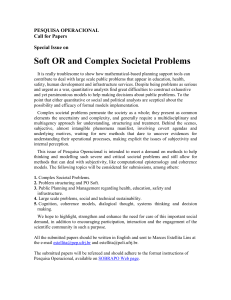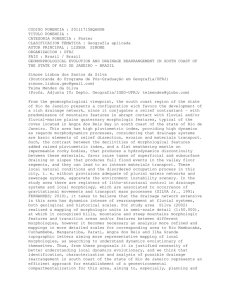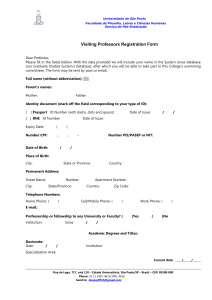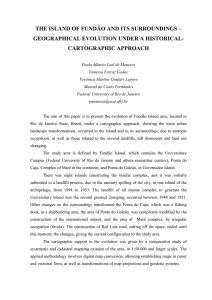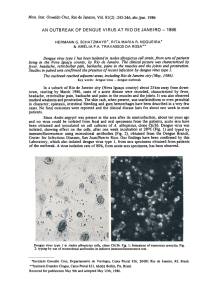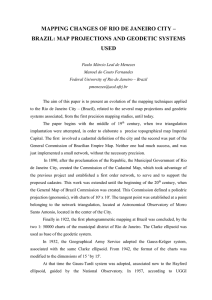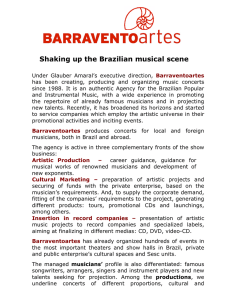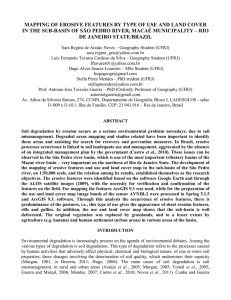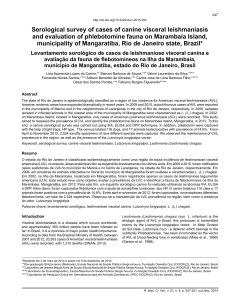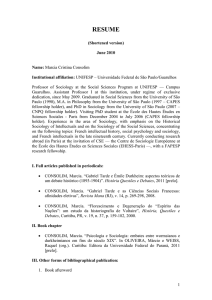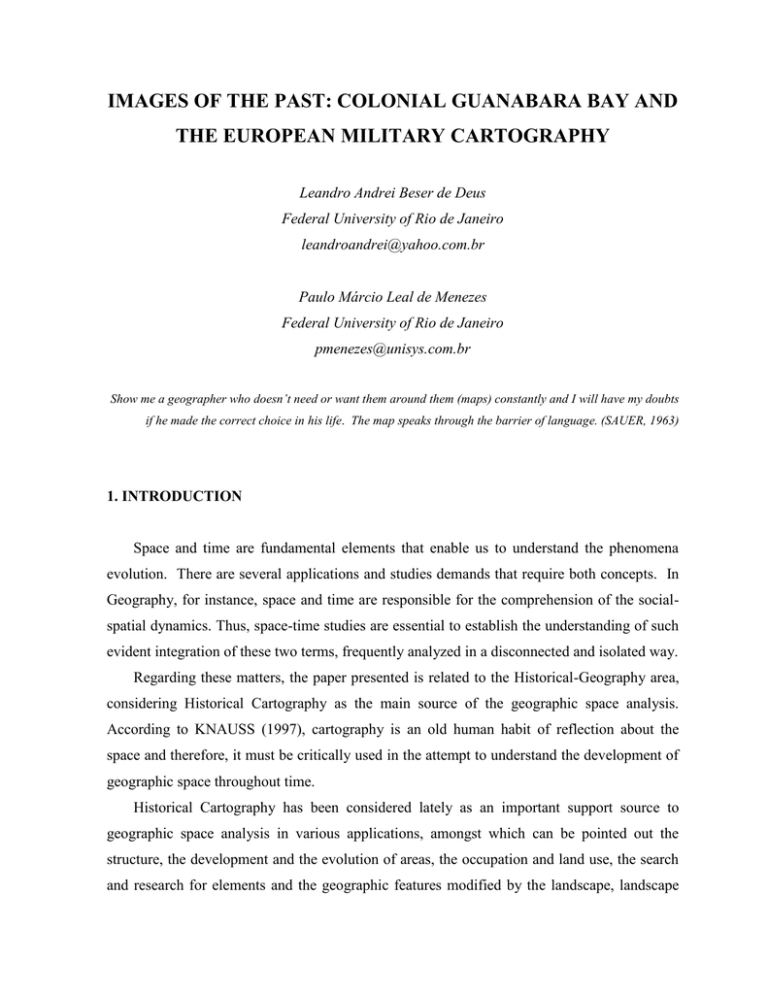
IMAGES OF THE PAST: COLONIAL GUANABARA BAY AND
THE EUROPEAN MILITARY CARTOGRAPHY
Leandro Andrei Beser de Deus
Federal University of Rio de Janeiro
[email protected]
Paulo Márcio Leal de Menezes
Federal University of Rio de Janeiro
[email protected]
Show me a geographer who doesn’t need or want them around them (maps) constantly and I will have my doubts
if he made the correct choice in his life. The map speaks through the barrier of language. (SAUER, 1963)
1. INTRODUCTION
Space and time are fundamental elements that enable us to understand the phenomena
evolution. There are several applications and studies demands that require both concepts. In
Geography, for instance, space and time are responsible for the comprehension of the socialspatial dynamics. Thus, space-time studies are essential to establish the understanding of such
evident integration of these two terms, frequently analyzed in a disconnected and isolated way.
Regarding these matters, the paper presented is related to the Historical-Geography area,
considering Historical Cartography as the main source of the geographic space analysis.
According to KNAUSS (1997), cartography is an old human habit of reflection about the
space and therefore, it must be critically used in the attempt to understand the development of
geographic space throughout time.
Historical Cartography has been considered lately as an important support source to
geographic space analysis in various applications, amongst which can be pointed out the
structure, the development and the evolution of areas, the occupation and land use, the search
and research for elements and the geographic features modified by the landscape, landscape
alterations caused by earthworks, rectification of the hydrography, hills dismount, etc.
According to MENEZES (et al., 2005), Historical Cartography objective is to study maps and
old cartographic representations, made in the past according to old techniques and methods.
To this Historical Cartography study, one intends to highlight the Military Cartography,
which is understood as the cartographic part that shows military aspects. Old military maps, as
historical sources, will be read and studied critically, because rather than representing the
space, they represent what the cartographer or the institution who made it, wished to show
graphically.
Lately, the studies involving Historical Cartography can be subsidized by tools as the GIS
(Geographic Information Systems) which help making decisions and have already enabled the
development of some analysis methods, planning and decision regarding the geographic space.
The use of a space-time model in GIS increases its analysis capability, making the study of the
geographic phenomena evolution possible.
The importance of Historical Cartography and Geotechnologies integration especially
with the GIS, reflects in the capability these two disciplines will have to organize the data
gathered and to provide a past spatial dynamics comprehension of` the spatial scale chosen to
be studied despite its limitations, restrictions and different analysis methods.
Figure 1 – Center of Rio de Janeiro – 1838 – Original e Centro of Rio de Janeiro – Atlas 1965
based in map of 1930 (MENEZES et al., 2005).
1.1. THE SPACE AND TIME OF STUDY
2
The scene chosen for the study is the Guanabara Bay region, located in the Captainship of
Rio De Janeiro (Brazil). The study will be subsidized by the European Military Cartography
(specifically from Portugal, France, Spain and England), regarding the Brazilian colonial
period (since the arrival of the Portuguese until 1822), that stands out the geopolitical interest
in Rio de Janeiro. The choice of the region was made due to its spatial scale full of
transformations (that took place throughout History since the sixteenth century). As we know
all process requires time, this one could be considered the ideal study for the accomplishment
of the paper. The "focus-process" of this work fits the action of Portuguese Cartographic
Politics in Colonial Brazil. Those politics were responsible for the occupation, defense and
territorial management and ended up in various spatial configurations, in addition to acting in
the spatial financial valuation of lots of fragments from Guanabara Bay and its surroundings,
throughout time. Moreover, there are other historical interests which were crucial for the
history of occupation of the Bay by Spain, France and England.
In order to study this space, we must draw a comparison between it and two other types of
scales. The first is the framing scale that corresponds to the captainship or the state of the Rio
de Janeiro and enables us to understand the changes that could be observed in this littoral
band. The other scale includes local and urban space maps as well as buildings plants,
however, only in the military scope. The reflections about the comparison between this
cartographic universe is the main concern of this work.
Figure 2 – Guanabara Bay – 1586, 1698 e 1767 (adapted of COSTA, 2004).
3
1.2. THE PROBLEMATIC
As has already been evidenced, Guanabara Bay is a spatial scale full of historical
information. Its dynamics has been through changes at specific and non-identified time
intervals. Facing these facts, some questions that can be answered or thought considering the
analysis subsidized by the Historical Cartography and by a Temporal Geographic Information
System. The central problematic lies to the occupation and defense of Guanabara Bay, which
will be analyzed through the comparison of its Portuguese, Spanish, Frenchmen and English
representations with different objectives and standpoints. These different points of view will
improve the understanding of the conjectural representations dealt with in computational
environments.
The cartographic representations will disclose military interests through
occupation strategies and some spatial tendencies. Consequently, the spatial dynamics
financial valuation of some scales will be more easily understood.
2. OBJECTIVES
The main objective of this paper is to understand the modifications in the space
organization of Guanabara Bay starting from the Portuguese, Spanish, French and English
cartographic production in the Brazilian colonial period, based on specific methodology for
historical-geographic studies. Such methodology resulted from a careful analysis of old maps
and of the integration of Historical Cartography with the Geotechnologies, in order to support
works aimed at the understanding of the transformations and/or spatial scales evolution in
regional and urban areas.
3. JUSTIFICATION
In the general scope, this work can be justified as a theoretical and methodological
reflection as well as a source of information to be incorporated to the historical-geographic
and cartographic property of the countries involved, strengthening the scientific and
technological cooperation between Latin America and the European Union. In the specific
4
scope, in order to develop the paper, two types of difficulties which must be equated can be
cited, justifying the present paper:
The first one lies inside a historical domain, especially regarding the historical research
sources, its origins (since they can be found in various countries), representations and
interpretations and the absence of maps of some colonial periods of Rio de Janeiro.
The other one lies inside a personal domain regarding the time insertion problems in GIS,
where several impeditive aspects for the accomplishment of this work can be observed.
4. METHODOLOGY
The work will be carried out on the following phases (detailed in the items below),
showing the methodology to be applied to the paper:
Phase 1: Bibliographical survey;
Phase 2: Cartographic, Geographic and Historical Data Acquisition
Phase 3: Temporal compartmentalization of the Study Periods:
Phase 4: Cartographic Historical Bases Spatial integration;
Phase 4.1: Digitalization and rasterization
Phase 4.2: Vectorization
Phase 4.3: Validation;
Phase 4.4: Georeferencing;
Phase 5: Graphical and Tabular Data Treatment;
Phase 5.1: Space-Temporal analogical analyses;
Phase 5.2: Space-Temporal digital analysis;
Phase 6: Conclusions.
5. PRELIMINAR RESULTS
Specifically on phase 2, we can already count on some material gathered in Brazil that it
will allow us to establish an x-ray of the area which will be allied and compared with the
available historical documentation (in archives, libraries, inquiry centers inquiry and also with
specialists) gathered in the European institutions.
5
Figure 3 – Francisco João Honesto Map – 1778 (MENEZES, 2005).
Bellow it is possible to observe some institutions researched preliminarily and some
of the contacts established:
In Portugal: University of Porto (Universidade do Porto), University of Lisbon
(Universidade de Lisboa), Historical Archive of the Army (Instituto Geográfico do
Exercito), Services of Engineering Direction (Direcção dos Serviços de Engenharia);
Army Geographic Institute (Instituto Geográfico do Exercito), National Library
(Biblioteca Nacional), Overseas Historical Archive (Histórico Ultramarino),
Portuguese Academy of History (Academia Portuguesa da História), among others.
Moreover, the contact and support from Professor João Garcia, Cartography History
specialist and supervising professor the present paper.
In Spain: Catographic Intitute of Catalunya (Institut Cartogràfic de Catalunya),
Nautical Museum of Madrid (Museo Naval de Madrid), University of Santiago de
Compostela (Facultades de Xeografía e Historia - University of Santiago de
Compostela), National Library of Spain (Biblioteca National de España), National
6
Historical Archive (Archivo Histórico Nacional), among others. Contacts made in
the ICC (International Cartographic Conference - 2005) in La Corunna; event with
publication and participation of the author.
France: The National Library of France (Bibliothèque Nationale de France, Institut
Géographique National), The National Geographic Institute (Institut Géographique
National), The National French Archives (Archives Nationales Françaises), Marine
Hydrographic Service (Service Hydrographique de la Marine),
Section
Géographique Militaire, Commission Nationale of toponymie, among others.
Contact: Marli Cigagna, Ph.doctor in Cartography by the University of Sorbonne
Nouvelle (Paris III), Paris, France.
In England: (United Kingdom): various institutions as the British Patrimony, The
National Archives, The British Library and contact to be made with the Brazilian
Luciana de Lima Martins, researcher of the Social and Cultural Geography Group of
Royal Holloway, University of London. This researcher gathered documents in the
United Kingdom in which travelers would describe the New World using aesthetic
and technical codes to be deciphered by their pairs. She also published a study called
“Brazilian Landscapes, British eyes” which contemplates the Brazilian landscapes
according to the British point of view. Her temporal scale corresponds to the end of
the seventeenth century and part of the eighteenth century, her research period focus,
when Great Britain used to be the biggest world-wide power. MARTINS (2001)
points out that in this period art and science had never been so close. The eyes which
mapped, measured and compared the landscapes features were also delighted by
doing a picturesque comparison of the same landscapes. Nowadays, these drawings
worth is also historical.
MARTINS (2001) claims to have obtained with such
drawings, certifications of the past times of Rio de Janeiro as well as clues about the
development of a new look towards landscapes and therefore of the emergence of the
modern observer.
6. FINAL CONSIDERATIONS
7
In summary, this work searched to divulge a study possibility integrating the Historical
Cartography, the Military Cartography and the Geotechnologies. The intended study is in the
beginning phase of research. However, it already presents some perspectives and possibilities
for contacts and products. Some results are waited, such as:
Searching for old maps and other sources in European institutions about the Guanabara
Bay in the colonial period;
Comparing cartographic images made at the same period, following the analogical analysis
method;
Establishing a geographic and geopolitical comparative study analyzing the moments of
each representation of the Bay considering the historical-geographic context of Rio de
Janeiro and in other analysis scales;
Presenting the technological evolution of the representations. The presence of a projection
system, a system of coordinates (spherical or plan), the representation of parallels and
meridians, orientation and scales can provide conclusive elements on the cartographic
knowledge of the past if compared to the document and the cartographer who made it;
Presenting a cartographic evolution of the processes (occupation and defense), maps,
letters that represent the Guanabara Bay throughout time, also appealing to the production
of conjectural maps;
Studying the space organization evolution and the structure of Guanabara Bay, as well as
its modifications and consequences for the inhabitants of this area, besides implementing
concepts on space financial valuation throughout time;
Studying the information mapping techniques indicating a connection between
Cartography, Geography, History and Geoprocessing knowledge;
Implementing a Temporal Geographic Information System (TGIS) which will organize the
gathered data and generate information about it using a space-temporal analysis in addition
to it the TGIS will subside this area space organization throughout history.
7. BIBLIOGRAPHICAL SURVEY
7.1. GENERAL BIBLIOGRAPHY
8
ARONOFF, S. Geographic Information Systems: A Manegement Perspective. Ottawa:
WDL Publications, 1989. 326 p.
BAGROW, L. History of cartography. Revista ampliada por R. A. Skelton. Chicago,
Precedent Publishing, 1985.
BARRACLOUGH, G. Introdução à História Contemporânea. Rio de Janeiro: Zahar, 1983.
BESER DE DEUS, L. A. Tempo em Sistemas de Informações Geográficas. Dissertação de
Mestrado. IME, 2005.
BESER DE DEUS, L. A. Conceptual Basis for Time Usage in Gis. In.: Anais do XXII
International Cartographic Conference, 2005.
BLACK, J. Maps and History: Constructing Images of the Past. New Haven: Yale
University Press, 1997.
BRADFORD, M.G. e KENT, W.A. Geografia Humana. Lisboa: Gradiva, 1987.
BRAUDEL, F. O Mediterrâneo e o mundo Mediterrânico na época de Felipe II (vol.1).
São Paulo: Martins Fonte, 1983.
BRAUDEL, F. História e Ciências Sociais. 6. ed. Lisboa: Presença, 1990.
BURKE, P. (Org). A Escrita da História: novas perspectivas. Tradução: Magda Lopes,
Unesp -- 1992, SP.
CANDY, J. T.: Development of a Prototype Temporal Geographic Information System.
Dissertação de Mestrado. Simon Fraser University - Department of Geography, 1995.
CARTOGRAFIA e Cartógrafos Portugueses dos Séculos XVI e XVII, Armando Cortesão.
CASTIGLIONE, L. H. G. Uma viagem epistemológica ao geoprocessamento. Rio de
Janeiro, ENCE. Dissertação de Mestrado, 2003.
CASTRO, I; CORREA, R e G., Paulo C (Orgs.). Explorações Geográficas. Rio de Janeiro:
Bertrand Brasil, 1997.
CASTRO, M. C. SIG – Sistema de Informação Geográfico ou sig - sintetizador de ilusões
geográficas – Desconstrução de uma formação discursiva. Rio de Janeiro: UFRJ. Tese
de doutorado, 1999.
9
CASTRO, T. Estudos de Geo-história. Rio de Janeiro – São Paulo: Distribuidora Record,
1971.
CENTRO DE ARQUITETURA E URBANISMO DO RIO DE JANEIRO, Do Cosmógrafo
ao Satélite: Mapas da Cidade do Rio de Janeiro, UFRJ, FUJB, 2000
CORRÊA, R. L. Espaço: um conceito-chave da Geografia. In: Geografia: conceitos e temas
/ organizado por Iná Elias de Castro, Paulo César da Costa Gomes, Roberto Lobato
Corrêa. 3. ed. Rio de Janeiro: Bertrand Brasil, 2001.
CORRÊA, R. L. Região e Organização Espacial. Rio de Janeiro: Editora Ática, 2002. 93p.
CORRÊA, R. L.; et al. Geografia: conceitos e temas / organizado por Iná Elias de Castro,
Paulo César da Costa Gomes, Roberto Lobato Corrêa. 3. ed. Rio de Janeiro: Bertrand
Brasil, 2001.
CORRÊA, R. L.; ROSENDAHL, Z. Paisagem, imaginário e espaço. Rio de Janeiro:
EdUERJ, 1999.
CORRÊA, R. L.; ROSENDAHL, Z. Paisagem, tempo e cultura. Rio de Janeiro: EdUERJ,
1998.
CORTESÃO, J. Curso de história da cartografia, MRE, 1944.
DELEUZE, G. & GUATTARI, F. Mil Platôs. São Paulo: 34 Editora, 2001.
DELEUZE, G. & GUATTARI, F. O que é Filosofia? São Paulo: 34 Editora, 2000.
DIAS, M. Os primórdios da moderna Cartografia militar em Portugal: uma história
ainda por contar. In.: Contributos para a História da Cartografia Militar Portuguesa.
Lisboa, 2003. Disponível em: CD ROM.
DIAS, M.; GARCIA, J.; RODRIGUES, M.; MOREIRA, L. Contributos para a História da
Cartografia Militar Portuguesa. Lisboa, 2003. Disponível em: CD ROM.
EDELWEISS, N. Banco de Dados Temporais: Teoria e Prática. In.: XVII Anais da Jornada
de Atualização em informática, do XVIII Congresso Nacional da Sociedade Brasileira em
Informática, v.2. Recife: Editora H. P. MOURA, 1998. p 225-282.
ELIAS, N. Sobre o tempo. Rio de Janeiro: Jorge Zahar Editora, 1998.
EZZEL, C. Tempo e cultura. Scientific American. São Paulo: Editora Duetto, ano 1, n. 5,
10
outubro de 2002. p. 86-87.
FERREIRA, C.C. e SIMÕES, N.N. A evolução do pensamento Geográfico. Lisboa:
Gradiva, 1986.
FOUCAULT, M. Questions on Geography. In: C. Gordon (org.), Power/Knowledge:
Selected Interviews and Other Writings 1972-1977, 63-77.
GOMES, Paulo César. Geografia e Modernidade. Rio de Janeiro: Bertrand Brasil, 1996.
GRANDE Enciclopédia Luso Brasileira;
GUEDES, M. Estudo e Pesquisa da Cartografia Histórica: Possibilidades e Desafios. USP:
Encontro de Cartografia Histórica, 2003.
HARVEY, D. Condição Pós-Moderna. São Paulo: Edições Loyola, 1994.
HARVEY, D., Explanation in Geography. Edward Arnold, London, 1969.
ISNARD, H. O Espaço Geográfico. Coimbra: Livraria Almedina, 1982.
KNOWLES, A. K. Past time, past place: GIS for History. Redlands Clifornia, ESRI Press,
2002.
LACOSTE, Y. Para Ler Braudel. Campinas: Papirus, 1992.
LANGRAN, G. Time in Geographic Information Systems. London/Washington, DC:
Taylor & Francis, 1993. 189p
LATOUCHE, S. A Ocidentalização do Mundo. Petrópolis: Vozes, 1992.
LAURINI, R. & THOMPSON, D., Fundamental of Spatial Information Systems,
Academic Press, San Diego, 680 pp. 1994.
MEDEIROS, C. B.; BOTELHO, M. A. Tratamento do Tempo em SIG. GIS Brasil 96, 1996.
p. 534-544.
MELLO, J.M.C. de. O Capitalismo Tardio. São Paulo: Brasiliense, 1986.
MENEZES, P. M. L. et al. Cartografia Histórica - Revisão de Conceitos e a Análise
Geográfica. In.: Anais do XXII Congresso Brasileiro de Cartografia, 2005.
MONMONIER, M. S. Rhumb Lines and Map Wars: A Social History of the Mercator
Projection. University of Chicago Press, 2004.
11
MORAES, A. C. R. & COSTA, W. M. C. A valorização do espaço. Geografia Crítica. São
Paulo: HUCITEC, 1999.
MOREIRA, R. O que é geografia. São Paulo: Brasiliense, 1994.
PEUQUET, D. It´s About Time: A Conceptual Framework for the Representation of
Temporal Dynamics in GIS. In: Annals of the American Association of Geographers, 84
(3), 1994.
PEUQUET, D. Representations of Space and Time. New York: Guilford Publications, 2002.
PIETTRE, B. Filosofia e Ciência do Tempo. Bauru, SP: EDUSC, 1997.
RAGO, M.; ORLANDI, L.; VEIGA-NETO, A. Imagens de Focault e Deleuze –
ressonâncias nietzschianas. Rio de Janeiro: DP&A, 2005, 2. ed.
RAY, C. Tempo, espaço e filosofia. Campinas, SP: Papirus, 1993.
ROBINSON, A. H., MORRISON, J. L., MUEHRCKE, P. C., KIMERLING, A. J. and
GUPTILL, S. C., Elements of Cartography – 6th Ed, 544 pp, New York, John Willey &
Sons. 1995.
SANTOS, M. A Natureza do Espaço: técnica e tempo, razão e emoção. São Paulo: Hucitec,
1996.
SANTOS, M. Por uma geografia nova: Da Crítica da Geografia a uma Geografia Crítica.
São Paulo: Editora da Universidade de São Paulo, 2002.
SAUER, C. O., ed John Barger Leighly. Land and Life: A Selection from the Writings of
Carl Ortwin Sauer. Berkeley: University of California Press, 1963.
SELLIS, T. et al. Research Network for Spatiotemporal Database Systems. SIGMOD
Records, New York, v.28, n.3, 1999.
SILVA, G. Z.; SOUZA, J. M. Futuras direções em SIGs: o que os usuários devem esperar
dos novos sistemas. I Semana Estadual de Geoprocessamento - SEGEO, Rio de Janeiro –
RJ, de 7 a 11 de Outubro de 1996.
SOJA, E. W. Geografias Pós-Modernas: a reafirmação do espaço na teoria social crítica.
Rio de Janeiro:Zahar, 1993.
STIX, G. Tempo real. Scientific American. São Paulo: Editora Duetto, ano 1, n. 5, outubro de
12
2002. p. 50-53.
THOM, L. H.; FORNARI, M. R. Estudo de banco de dados temporais espaciais. Trabalho
para Disciplina CMP 161. Sistemas de Informação Geográfica. Prof. Dr. Cirano Iochpe.
UFRGS, 2000.
THROWER, J.W. N., Maps and civilization: cartography in culture and society,
University of Chicago Press, Chicago, p. 254. 1996.
TUAN, Y. Tempo e Lugar. In: Espaço e Lugar: perspectiva da experiência. São Paulo: Difel,
1977.
VASILIEV, I. R. Mapping Time. In.: Cartographica, monography 49, maio, 1997.
WALLERSTEIN, E. O Capitalismo Histórico. São Paulo: Brasiliense, 1985.
WALLERSTEIN, I. The Time of Space and the Space of Time: The Future of Social
Science. In: Political Geography, XVII, 1, 1998.
7.2. SPECIFIC BIBLIOGRAPHY
ABREU, M. A. A Evolução Urbana do Rio de Janeiro. 2. ed. Rio de Janeiro:
IPLANRIO/Zahar, 1988.
ÁBREU, M. A. Construindo uma geografia do passado. In.: Revista GEOUSP, n. 7. 2000.
ABREU, M. A. Pensando a Cidade no Brasil do Passado.In: Castro, Iná E., Gomes, Paulo
C., Correa, Roberto L(orgs) Brasil: Questões Atuais de Reorganização do Território. Rio
de Janeiro: Bertrand Brasil, 1996. 468 p.
ABREU, M. A. Sobre a memória das cidades. Território, Rio de Janeiro: LAGET, ano III,
n.4, p. 426, jan./jun. 1998.
ABREU, M. A. Mapas Conjecturais do Rio de Janeiro Quinhentista. In: Resumos – I
Simpósio Luso-Brasileiro de Cartografia Histórica, 2005.
13
ADONIAS, I. Catálogo de plantas e mapas da cidade do Rio de Janeiro, Rio de Janeiro,
Ministério das Relações Exteriores, 1965.
ADONIAS, I. Mapa: imagens da formação territorial brasileira, Rio de Janeiro, Fund.
Emílio Odebrecht, 1993.
ADONIAS, I. Catálogos. In: Estudo e Pesquisa da Cartografia Histórica: Possibilidades e
Desafios. USP: Encontro de Cartografia Histórica, 2003.
ALBUQUERQUE, Luís de. O Tratado de Tordesilhas e o Descobrimento do Brasil. In:
Crónicas de História de Portugal, Lisboa: Presença, 1987, 50-55.
AMADO, J. e FIGUEIREDO, L.C. O Brasil no Império Português. Rio de Janeiro: Zahar,
2001.
AMADOR, E., Ecossistema Periférico: Homem e Natureza.
ANAYA, E. G. Cristóbal Colón – Diario de a bordo. Ed. castellana: Ediciones Generales
Anaya, S. A., Madrid, 1985.
ANTIQUE MAPS, Carl Moreland e David Bannister, Phaidon Press Limited, Reimpressão
2001, ISBN 0714829544;
BERNADES, L.; SOARES, M. Rio de Janeiro: Cidade e Região. Rio de Janeiro: SMC,
1990.
BESER DE DEUS, L. A. Evolução da Paisagem do Campo de Santana – Centro/RJ –
Através de Representações Cartográficas. Estágio de Campo III. Rio de Janeiro: UFRJ,
2003.
BARREIROS, C. Reprodução de documentos cartográficos da cidade do Rio de Janeiro –
série século XVI, s/l, ed.,d.
BARREIROS, E.
C. Atlas da evolução urbana da cidade do Rio de Janeiro, Rio de
Janeiro, IHGB, 1965.
BARREIROS, E. C. A cidade do Rio de Janeiro de sua fundação até fins do século XVII.
In: Revista do Instituto Histórico e Geográfico Brasileiro, v.288: 199-209. Rio de Janeiro,
1970.
COSTA, A. G. Cartografia da Conquista do Território das Minas. Org.: Antonio Gilberto
Costa. Editora UFMG; Lisboa:Kapa Editorial. Belo Horizonte, 2004.
14
DUARTE L. A exploração do litoral do Brasil na cartografia da primeira década do
século XVI. In: DIAS, Carlos Malheiros, dir. História da colonização portuguesa no
Brasil. Porto, Litografia nacional, 1921. v. II, cap XIII.
FERREZ, G. O Rio de Janeiro e a defesa de seu porto, 1555-1800, Rio de Janeiro, SDGM,
1972.
FUNDREM, Fundação do Desenvolvimento da Região Metropolitana, Mapeamento 1: 10
000, 1975.
GARCIA, R. O Brasil na cartografia do descobrimento. Cultura, ano 17, nº. 6, Rio de
Janeiro, MEC, dez/1954, pp. 163-181.
GUERRA, A. E.; SANTOS, M. M. As Cartografias do Século XVII e o Caso do Atlas
“Estado do Brasil”. In: I Simpósio Luso-Brasileiro de Cartografia Histórica, 2005.
IPP, Instituto Pereira Passos. Mapeamento Cadastral do Rio de Janeiro, 1998
IPP, Instituto Pereira Passos. O Rio de Janeiro no século XVI. Rio de Janeiro: Prefeitura da
Cidade do Rio de Janeiro, 2000. Disponível em: CD ROM.
IPP, Instituto Pereira Passos. Rio 500 anos – Uma janela no tempo sobre a cidade
maravilhosa. Rio de Janeiro: Prefeitura da Cidade do Rio de Janeiro, 2002. Disponível
em: CD ROM.
KNAUSS, P. Imagem do Espaço, Imagem da História. A Representação Espacial da
Cidade do Rio de Janeiro. São Paulo: USP, 1997.
JAYO, A. H. Brasil, uma construcción hispânica. In: I Simpósio Luso-Brasileiro de
Cartografia Histórica, 2005
LAMEGO, A. R., O Homem e a Guanabara, IBGE – Conselho Nacional de Geografia, 1964
LEITE, Duarte. Os Limites Primitivos do Brasil. In: História dos Descobrimentos,
Colectânea de Esparsos, ed. V. Magalhães Godinho, vol. I, Lisboa: Cosmos, 1959, 697712
LUCIMAR.
Memória
da
Hidrografia,
http://bodeverde.tripod.com/BV_HP06.htm.
15
2002.
Disponível
em:
MARTINS, L. L. Paisagens Brasileiras, Olhos Britânicos. Rio de Janeiro dos Viajantes
1800/1850. UFRJ: Tese de Doutorado, 1998.
MARTINS, L. L. O Rio de Janeiro dos viajantes: O olhar britânico, 1800-1850. Rio de
Janeiro: Jorge Zahar Editor, 2001.
MELLO JR., D. Rio de Janeiro: planos, plantas e aparências, Rio de Janeiro, João Fortes
Engenharia, 1988.
MENEZES, P. M. L. Evolução Histórica-Geográfica-Cartográfica da Ilha do Fundão. In.:
Anais do XXII Congresso Brasileiro de Cartografia, 2005.
MENEZES, P. M. L.; LEPORE, V.; ANDRADE, L.; SOUZA, B. Historical-Geographical
and Cartographic Evolution of Fundão Island – Brazil. In.: Anais do XXII
International Cartographic Conference, 2005.
SANTOS, M. Urbanização brasileira. São Paulo: Hucitec, 1993.
SARTHOU, C., Passado e Presente da Baía de Guanabara, Livraria Freitas Bastos S.ª, Rio
de Janeiro, 1964
SISSON, R. Marcos históricos e configurações espaciais, um estudo de caso – os centros
do Rio de Janeiro. In: Arquitetura Revista 4:56-81, Rio de Janeiro, FAU-UFRJ, 2º
semestre, 1986.
SOUZA, M. L. O ABC do Desenvolvimento Urbano. 1. ed. São Paulo: Bertrand, 2003.
189p.
16

